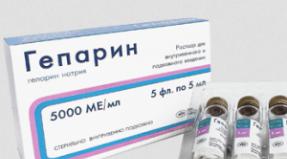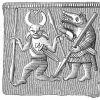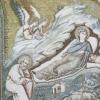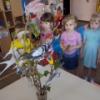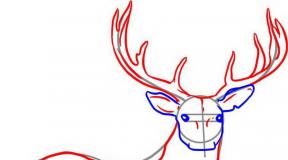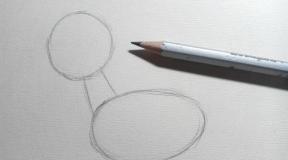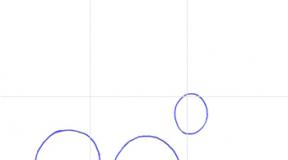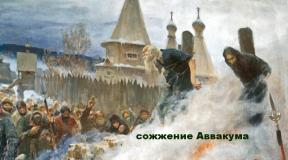Graph of the function y is the root of x presentation. "Function" root of x ", its properties and graphs". Game "Mathematical Lotto"
Function
its properties and schedule.

Oral work.
Find errors: Explain the answer.

Correct answers:
does not exist

Use the template to plot a function and list its properties.
at
0 1 2 3 4 5 6 7 8 9 10 11 12 13 14 15 16
NS
 0, _______. Therefore, the graph is located in the ___ quarter. Increase, decrease. Greatest and smallest value functions. Continuity of function. _ "width =" 640 "
0, _______. Therefore, the graph is located in the ___ quarter. Increase, decrease. Greatest and smallest value functions. Continuity of function. _ "width =" 640 " Function properties
- D -?
- E -?
- When x = 0, ____; and for x 0, _______. Therefore, the graph is located in the ___ quarter.
- Increase, decrease.
- The highest and lowest value of the function.
- Continuity of function.

NS
Have
NS ≥ 0
1 2 3 4 5 6 7 8 9 10 11

Self-study assignments:
- List function properties
- Determine if the points belong to the graph of the function.
 0, then at 0. Therefore, the graph is located in 4 quarters. The function decreases in the interval. The maximum value of the function is 0, it is reached at y = 0. The function is continuous. _ "width =" 640 "
0, then at 0. Therefore, the graph is located in 4 quarters. The function decreases in the interval. The maximum value of the function is 0, it is reached at y = 0. The function is continuous. _ "width =" 640 " Self-test. Function properties
- If x = 0, then y = 0; and if x 0, then y 0. Therefore, the graph is located in the 4th quarter.
- The function decreases in the interval
- The largest value of the function is 0, it is achieved at y = 0.
- Functions are continuous.

Self-test:
- A (81; -9). x = 81, y = - 9.
The answer is yes
2) B (-25; 625). x = -25; y = 625.
The answer is no.
The answer is yes

Solve the equation graphically:
Let us construct the graphs of the functions in one coordinate system:
0 1 2 3 4 5 6 9
NS
Have
y = x-6
NS
Have
Find the abscissa of the intersection points of the graphs
NS =9
ANSWER:

- ANSWERS:
- a) 1; b) 1.
- ANSWERS:
- a) (4; - 2); b) (0; 0); (4; - 2).

- Horizontally:
- The action by which the square root is found.
- The quarter in which the function graph is located
- Square root of 144.
- An infinite fraction with repeating numbers.
- Dependence of one variable on another.
- A rational number is ……… an integer to a natural number.
- Vertically:
- The name of the expression containing the roots.
- Ancient Greek mathematician who proved that he was not a rational number.
- Arithmetic root.
- Function graph y = x 2

Trigger is used. When you click on the red numbers - horizontal answers. When you click on the blue numbers, the answers are vertical.

Ancient Greek mathematician Euclid
- Date of birth: about 325 BC
- Place of birth: or Athens, or Shooting gallery
- Scientific area: maths
- The main work is "Beginnings".
- Known as: "The Father of Geometry".
- Author of works on astronomy, optics, music, etc.

- Homework:
- Paragraph 13, No. 9, No. 11.
Sections: Maths
Goals: to consolidate the knowledge of the properties of the function when performing exercises, to check the skills and abilities of students and the degree of assimilation of the studied material by them in the course of independent work, to repeat the previously studied material.
Tasks: encourage students to self-control, mutual control, introspection of their learning activities. Develop creative and mental thinking.
Method of work in the lesson:
Students work in pairs. Each desk is a separate option. It is advisable to seat the children with a weak student - a strong one.
An envelope with 1) an assessment sheet, 2) a sheet for oral work, 3) the "Lotto" task + a rebus is distributed to each school desk.
In the previous lesson, you can set home independent work according to the options:
Task 1. Construct a shape, limited by the graphs of functions.
Option 1. ![]()
Option 2. ![]()
Stage 1. Organizational moment (3 minutes) Greetings. Submit a topic. Tell the plan of work in the lesson. The work consists of three stages. Students enter the results of each stage on individual assessment sheets. (distribute the scorecard from Appendix 2)
Stage 2. Checking homework (5 min)
Students exchange their notebooks with an adjacent desk.
1 student at the blackboard shows solution number 350 Slide 3
Homework check # 1. Slide 4
We calculate the number of points: for a correctly performed number 350 - 1 point, for a correctly performed independent work, we put points as follows: for each correctly constructed graph, 1 point, 1 point for a correctly designated figure. The result is 5 points for 2 tasks performed correctly. We put points in the score sheet. Slide 6
Stage 3. Oral work (theory review) (5 min) Slide 6
Distribute the oral work assignment sheet to the students (see Appendix 2)
2 minutes . For checking. Verification with mutual control (again changing answers). Slide 7
Stage 4. Practical part (20 min) Slide 10-13
Purpose: to be able to determine the belonging of a point without building a graph, by using the properties of the graph of the function to compare numbers, to facilitate teamwork and to develop the cognitive process with the help of puzzles.
Students on the desk have a card with an assignment, an envelope with answer options (9 cards with different answers, but 3 have the correct ones) and an empty card with the assignment number for composing a rebus.
The tasks are composed in such a way that the first two letters are solved by one student, and the second two letters are solved by the second student, and only No. 3 is solved together.
"Lotto" - differentiated independent work(performed by options and in pairs)
Exercise 1. Solve 3 tasks from the option written on the map, find the cards with the correct answers and close the corresponding tasks with them, then a rebus will turn out on their upper side.
Task 2. Solve the puzzle by answering the question.
IN 1. What other name does the arithmetic square root have?
IN 2. What mathematician once remarked that: “A mathematical theory can be considered perfect only when you have made it so clear that you undertake to present its content to the first person you come across?
"Lotto" Option 1 |
|
| # 1. At what point does the graph of the function and the straight line intersect? | |
| a) y = 2; b) 2y = 3 | c) y = -2; d) y = 4. |
| C (1600; 40), N (900; -30) | E (0.81; 0.9); P (0.5; 0.25) |
| No. 3. Compare the numbers A) ; b); v) ; G) ; e). |
|
"Lotto" Option 2 |
|
| # 1. At what point does the graph of the function and the straight line intersect? | |
| a) y = 3; b) 2y = 5 | c) y = -3; d) y = 6. |
| # 2. Which of the points belong to the graph of the function | |
| A (2500; 50), C (400; -20) | B (0.64; 0.8); P (0.3; 0.09) |
| No. 3. Compare the numbers A) ; b); v) ; G) ; e). |
|
Answer card:
2. Write down differentiated homework
“3” – 357
“4” - 357 + 351 (b, d)
“5” - 357 + 351 (b, d) + 456
Individual homework for strong learners:
Construct graphs of functions in one coordinate system and draw conclusions about what happens to the graph of a function. (graph conversion has not been studied yet).
Hello!
Today we have an unusual activity. We will give a math lesson in health.
Together with the "consolidation" of mathematical knowledge, we will recall the main secrets of health.
And the epigraph of the lesson will be the words "The great book of health is written in mathematical symbols"
How do you understand these words?
Without mathematical knowledge, no science is possible, and even such as the science of health. And we will be convinced of this today.
So, in the last lesson we got acquainted with the function
, its properties and schedule.
Sign the number and topic of the lesson.
I suggest you, in the course of the survey, determine what knowledge you need to remember and apply today?
2. Actualization of theoretical knowledge (frontal survey) (5 min.)
Assignment: Add phrases.
A) The arithmetic square root of the number a is called ...
V) The expression is meaningless when ...
WITH) The function graph is ...
D) The function has distinctive ...
E) According to the graph of the function, it is possible to determine ...
What tasks will we set for ourselves?
Tasks: improve the ability to build a graph of a function of the form y =  , repeat the properties of this function, check the assimilation of the material by finding square roots, through the solution of expressions and equations.
, repeat the properties of this function, check the assimilation of the material by finding square roots, through the solution of expressions and equations.
As you noticed, the letters denoting a sequence of phrases are capital Latin. In medicine, vitamins are so designated. This list contains a group of vitamins that are present in many food products and help you see well, be resistant to colds and stressful situations.
That's why, The first rule of health is healthy and proper nutrition.
- To discover the second secret of health, let's sit down correctly and play math lotto together.
Computational warm-up. (8 min.)
Game "Mathematical Lotto"
Calculate 
Calculate, give the correct answer 
What integer is enclosed between  and
and 
That more  ,
,  ; 3,2 ?
; 3,2 ?
Find the largest value of the function y = on the interval from 1 to 25
Solve the equation  =4
=4
Find the largest root of the equation  x2 = 4
x2 = 4
Calculate 
Calculate  +
+ 
Calculate 
Find the side of a square if its area is 64 cm2
Find the perimeter of a square if its area is 9 cm2
-The second secret of health is the daily routine... This is the right combination and alternation of work, occupation and rest. Under the heading "It's interesting!" we learn about the famous mathematician's daily routine.
4. This is interesting! (3 min.)
Pythagoras is perhaps the most popular scientist in the entire history of mankind. Mathematician, mechanic, musician, Olympic champion of antiquity, the name of no scientist is not repeated so often. He established his own school, the students of the school were called Pythagoreans. It was very difficult to get into the Pythagorean school. Pythagoras worked out a special daily routine for himself and his students. Having risen before sunrise, the Pythagoreans went to the seashore to meet the dawn, did gymnastic exercises, and had breakfast. At the end of the day, they went for walks, swimming in the sea and had dinner, and after dinner, they prayed to the gods and read.
And you and I will not violate the regime and will rest a little. Let's sit comfortably and watch the puck with our eyes.
5. An eye wash (2 min.)
This physical minute gives a hint about third health secret. What about?
- Sports activities, constant movement.
And now we will arrange a kind of mathematical competition between couples to test your knowledge on the topic of the lesson.
6. Practicing knowledge, skills, and abilities (10 min.)
1. Work in pairs (formation of 3 pairs).
Assignment: find inaccuracies in the proposed properties of a function  , mark the selected option with the checkbox of your pair, if possible first, and be sure to give the correct formulation of the property, otherwise the answer goes to the following pair:
, mark the selected option with the checkbox of your pair, if possible first, and be sure to give the correct formulation of the property, otherwise the answer goes to the following pair:
The domain of a function is a set of non-negative numbers (x≥0).
The range of values of the function is the set Z.
3. The function is increasing.
4.y = 0 at x = 0; y<0 при x<0; y>0 for x> 0
5. There is no largest or smallest function value.
6. The graph of the function is symmetric to the graph of the function y = x², where x≥0 relative to the straight line y = x.
7. Practical application of knowledge (10 min.)
The task in the textbook number 357 p.84:
Solve the equation graphically by one student at the blackboard with an oral explanation of the steps of the solution.
8. Reflection (3 min.)
Our lesson ends, let's summarize.
Was it interesting?
What knowledge and skills should have been applied in the lesson?
What's new they discovered for themselves in the lesson.
How's your mood? Does mood affect health? That's the last secret is "good mood".
Positive emotions are also necessary for healthy way life. Today in the lesson you experienced the joy of learning, satisfaction with your successes, goodwill in communication. Health is an invaluable asset not only of each individual person, but of the entire society.
Let's look at each other, smile and take this positive charge of emotion with us to the next lesson.
Take care of yourself, your health, and then mathematical problems will be solved faster and easier.
9. Homework (1 min.)
Clause 15 No. 365; No. 367;
No. 344 (a).
Thank you for the lesson!
"Determination of a numeric function" - Graphical way. Definition of a numeric function. Y = f (x). Analytical method. It is convenient to describe graphs by matrices. The function is set in a table. Verbal wording. A function y = f (x) is given. The function is set graphically. Function definition area. Express each variable in terms of the other two. Number set X and rule f.
"Functions" algebra "- The function F is called the antiderivative for the function f. "Integral from a to b eff from x de x". Let's find one of the antiderivatives for the function. Let's make a table. Derivative of trigonometric functions. Intersections with Oy. The method of intervals. The highest and lowest value of the function. We build a schedule. Derivative of a complex function.
"Elementary functions" - Power function with natural exponent. Elementary functions... The formula for the transition between logarithms. Arccosine. Maths. Formulas. Basic properties of degrees. Inverse trigonometric functions... Function properties. Exponential function. Basic meanings of arcsine and arcsine. Basic properties of logarithms.
The value of y at which x = 3. Check: The student at the blackboard. According to the schedule, determine: - The value of x, at which f (x) = 0. Exploring functions. Pupil at the blackboard. Consolidation of the passed material. Warm up. Within the scope of the school curriculum. - Define the properties of the given function. Methodical theme. 2. Is the linear function given by the formula and indicate K and B:
"Numerical functions" - The simplest examples of such interdependencies are given by geometry. Function graph. The set X is called the domain of assignment or the domain of definition of the function f and is denoted by D (f). Introduction. Example 1. A parachutist jumps from a "hovering" helicopter. Just one number. Definition. Definition Let X be a number set.
"Tasks for functions" - Variable. Functions. A certain number. Values. Variable dependency. Dependent variable. Lots of. Independent variable. Instructions for working with the simulator. Independent variable values. Argument values.
There are 16 presentations in total
Municipal educational institution
average comprehensive school №1
Art. Bryukhovetskaya
Municipal Formation Bryukhovetsky District
Mathematic teacher
Guchenko Angela Viktorovna
year 2014
Function y =
 , its properties and graph
, its properties and graph
Lesson type: learning new material
Lesson objectives:
Tasks solved in the lesson:
teach students to work independently;
make assumptions and guesses;
be able to generalize the studied factors.
Equipment: board, chalk, multimedia projector, handouts
Duration of the lesson.
Determining the topic of the lesson together with the students -1 minute.
Determining the goals and objectives of the lesson together with the students -1 minute.
Knowledge update (frontal survey) -3 min.
Oral work -3 min.
Explanation of the new material based on the creation of problem situations -7min.
Physical minute -2 minutes.
Plotting a graph together with the class with the design of the plot in notebooks and defining the properties of the function, working with the textbook -10 min.
Consolidation of the acquired knowledge and development of graph transformation skills -9min .
Summing up the lesson, establishing feedback -3 min.
Homework -1 minute.
Total 40 minutes.
During the classes.
Determination of the topic of the lesson together with the students (1min).
The topic of the lesson is determined by students using leading questions:
function- work performed by an organ, an organism as a whole.
function- possibility, option, skill of the program or device.
function- duty, range of activities.
function character in a literary work.
function- kind of subroutine in computer science
function in mathematics - the law of dependence of one quantity on another.
Determination of the goals and objectives of the lesson together with the students (1min).
The teacher, with the help of the students, formulates and articulates the goals and objectives of this lesson.
Knowledge update (frontal survey - 3 min).

Oral work - 3 min.
Frontal work.
(A and B belong, C does not)
Explanation of the new material (based on the creation of problem situations - 7min).
Problematic situation: describe the properties of an unknown function.
Divide the class into teams of 4-5 people, distribute forms for answering the questions posed
Form No. 1
y = 0, at x =?
Function definition area.
The set of function values.
Each question is answered by one of the team representatives, the rest of the teams vote “for” or “against” with signal cards and, if necessary, supplement the answers of classmates.
Together with the class, draw a conclusion about the domain of definition, the set of values, the zeros of the function y =.
Problem situation : try to plot an unknown function (there is a discussion in teams, search for a solution).
With the teacher, I recall the algorithm for plotting the graphs of functions. Students use teams to try to depict the graph of the function y = on the forms, then exchange the forms with each other for self-and cross-checking.
Fizminutka (Clownery)
Plotting a graph together with the class with the design of plotting in notebooks - 10 min.
After a general discussion, the task of constructing a graph of the function y = is performed individually by each student in a notebook. The teacher at this time provides differentiated assistance to students. After students complete the assignment, a function graph is shown on the board and students are asked to answer the following questions:



Output: together with the students, draw again the conclusion about the properties of the function and read them according to the textbook:

Consolidation of the acquired knowledge and development of the skills of transformation of the schedule - 9 min.
Students work according to their card (according to options), then change and check each other. After that, graphs are shown on the blackboard, and students evaluate their work by comparing with the blackboard.
Card number 1

Card number 2





Output: about graph transformations
1) parallel transfer along the OU axis
2) shift along the OX axis.
9. Summing up the results of the lesson, establishing feedback - 3 min.
SLIDES – insert missing words
Domain of this function, all numbers, except … (Negative).
The function graph is located in ... (I) quarters.
If the value of the argument is x = 0, the value ... (functions) y = ... (0).
The highest value of the function ... (does not exist), smallest value -… (equal to 0)
10. Assignment at home (with comments - 1 min).
According to the textbook- §13
By the book of problems- No. 13.3, No. 74 (repetition of incomplete quadratic equations)


